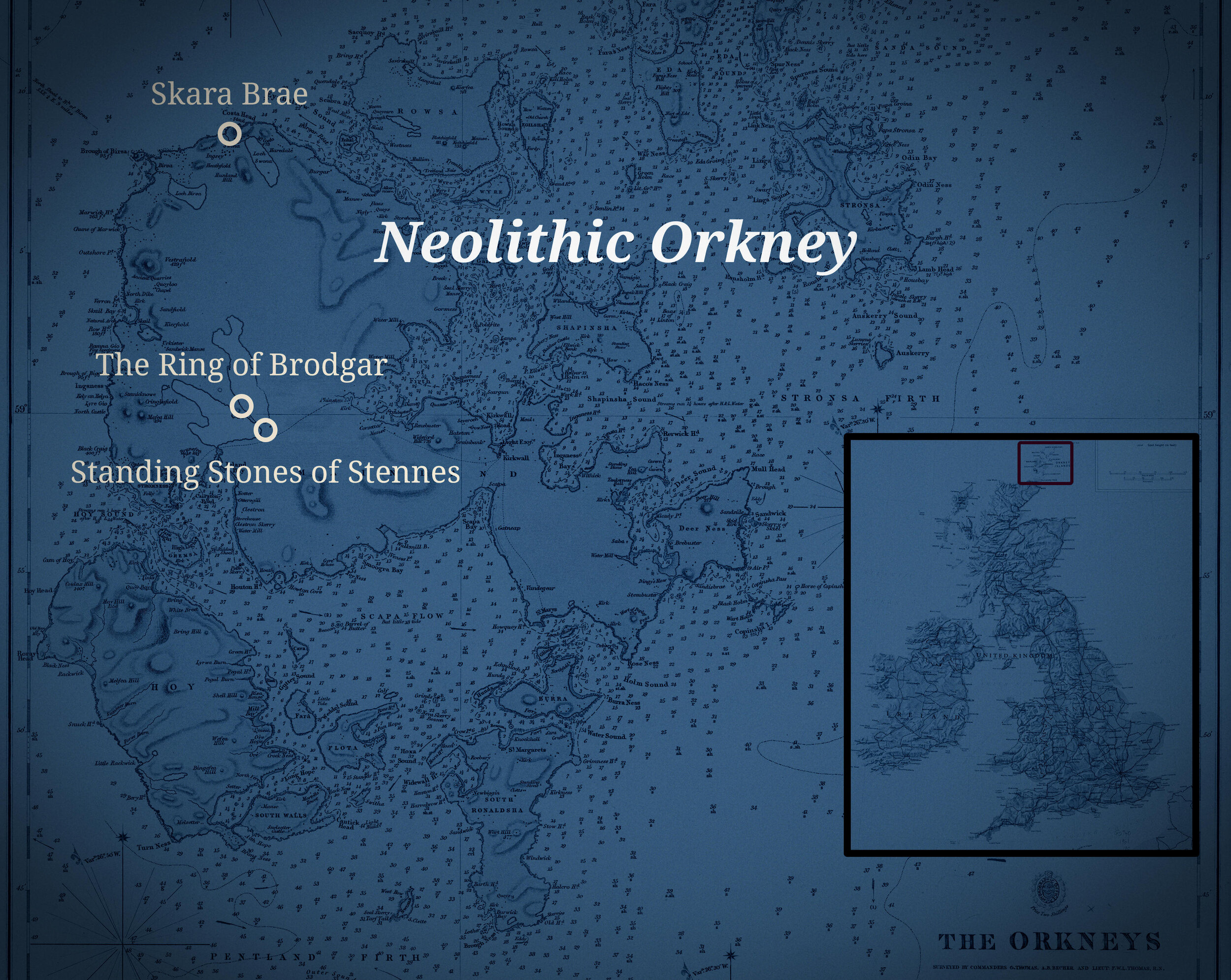Skara Brae: Neil Oliver (2,500 bc)
Neil_Oliver_2018 © Bill Osment
Beside the ocean, on the wind scoured coast of the Orkney Islands off the northern coast of Scotland, lies the remains of Skara Brae. This is the best-preserved Neolithic settlement in all of Western Europe and, for today’s guest Neil Oliver, it is a place that continues to enchant him.
In this beautifully-described episode he takes us back to the third millennium BC to see Skara Brae as it lived and to ponder why it died.
*** [About our format] ***
Long before the Golden Age of China, before the construction of the pyramids of Egypt, before the Harappan Civilisation in India, on a remote outcrop of islands off the northern coast of modern-day Scotland, the settlement of Skara Brae buzzed with life.
Skara Brae, as Neil Oliver explains in this episode, was a place that mattered. Archaeological work undertaken on the settlement over the last century and a half has exposed evdience of a rich, sophisticated society. The people who lived here farmed both cereals and animals; they worked skilfully with stone and organic materials like fur, fleece and whale bone. New forms of pottery were pioneered in the settlement. The little houses that people lived in were built to a regular plan and included clever features like flushing toilets.
But Skara Brae’s significance went beyond the domestic. Work on nearby monuments like the Ring of Brodgar has shown that these stone circles were first created by the Orcadians. The better-known sites in the south of England – like Stonehenge and Avebury – can be seen as children of what was happening in the distant north. Indeed, during the time that Skara Brae flourished - between around 3,000BC and 2,000BC - the common flow of culture was from north to south.
In this episode Oliver opts to travel back to this third century BC so that he can walk through Skara Brae at its height. He wants to observe, as he puts it, the ‘steaming fug of humanity.’ He later takes the chance to engage with a riddle that has long absorbed archaeologists. What happened? Why was this advanced, well-located, well connected settlement abandoned by its inhabitants?
One theory held that the people of Skara Brae had been the victims of an apocalyptic event. Perhaps they had been scattered by a tremendous storm, making Skara Brae something of a ‘Pompeii of the North’. New archaeological work, though, has undermined this old interpretation.
The settlement might have been abandoned for four thousand years, but to Oliver the way that the people lived there contains lessons for us today.
‘It is one of the places that does haunt my imagination,’ Oliver says. ‘I would love to go back and just sit quietly on the grass, on a decent day, and just watch a day in the life of Skara Brae, and listen to them, and smell the smells and hear the noise and see what they were about.’
***
All of this fascinating detail about Skara Brae can be found inside this episode of Travels Through Time. We also take the opportunity to catch up about Neil Oliver’s latest book, The Story of the World in 100 Moments.
*** Listen to the podcast ***
Show notes
Scene One: A day in the life of Skara Brae
Scene Two: The great mystery of the settlement's abandonment
Scene Three: Where did the people go?
Memento: A sharp stone knife
People/Social
Presenter: Peter Moore
Guest: Neil Oliver
Production: Maria Nolan
Podcast partner: Unseen Histories
Follow us on Twitter: @tttpodcast_
Or on Facebook
See where 2,500 BC fits on our Timeline
About Neil Oliver
Neil Oliver was born in Renfrewshire in Scotland. He studied archaeology at the University of Glasgow and worked as an archaeologist before training as a journalist. In 2002 he made his television debut presenting BBC2’s Two Men in a Trench in which he and Tony Pollard visited historic British battlefields. Since that time he has been a regular on TV, presenting A History of Scotland, Vikings, and Coast. He travels all the time, but his home is in Stirling, with his wife, three children and an Irish wolfhound.
Location of Skara Brae and the Orkney Islands
Background Map: Library of Congress // Wiki Commons
The Bridge of Brodgar, Stenness, 1875. By Walter Hugh Patton
Source: Wiki Commons
The Australian archaeologist Vere Gordon Childe spent considerable time working on Neolithic Orkney in the early twentieth century, significantly increasing public interest in the surviving monuments. This photograph from the 1930s shows a lady stopping off by the Ring of Brodgar during a motoring holiday. (Flickr)
Skara Brae, Orkney Islands by Mike McBey
Watch the interview on YouTube
Complementary episodes
The Neanderthals and their Wild Woodland World: Dr Rebecca Wragg Sykes (the Eemian)
In this fascinating and unusual episode of Travels Through Time the archaeologist and writer Dr Rebecca Wragg Sykes takes us back further than we’ve ever been before to meet our extinct kindred: the Neanderthals.
In the Shadow of Vesuvius: Dr Daisy Dunn (79 AD)
Early one afternoon in the year 79 AD, a seventeen year-old boy looked out from the window of his villa across the Bay of Naples. He saw a great cloud, ‘both strange and enormous in appearance’, rising from the top of a hill over the luxuriant landscape of Campania. So began a fateful day.













